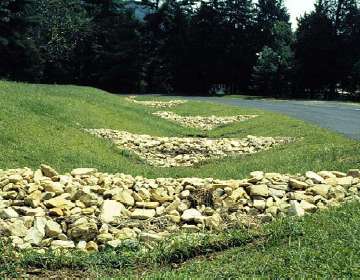3. Infiltration Trenches | 4. Bioswales | 5. Permeable Pavement
Bioswales
 |
| Bioswale with Check Dam. |
What is a Bioswale?
Bioswales are linear, vegetated ditches which allow for the collection, conveyance, filtration and infiltration of stormwater. The can also be referred to as "grass swales," "vegetated swales," or "filter strips."
Why use Bioswales?
Large parking lots systems and their connecting road networks, common in industrial complexes and office parks, shed large volumes of runoff because of their impervious surfaces. Traditionally, the water runs off the asphalt into a storm gutter or along a curb until it reaches the inlet to storm sewer drain. A bioswale replaces the traditional concrete gutter with an earthen one. The vegetation reduces the water's velocity allowing for treatment and infiltration. Because they behave like a gutter, these trenches are best suited along roadsides or parking lots, but are less practical for dealing with stormwater that falls on rooftops.
How do they manage stormwater?
Bioswales have four functions for stormwater management: collection, conveyance, filtration and infiltration. These four traits reduce and delay peak run off volumes as well as treat stormwater quality.
Stormwater is first collected in the trench, and if the water accumulates faster than it is carried away, then the water will pool. The reason why water accumulates in a bioswale and not in a gutter is that the vegetation adds roughness to the channel, greatly reducing the velocity. This effect delays the time of peak run off. The vegetation does more than reduce the velocity of the water, as plants filter suspended sediments from the water passing through them. While the plants remove these large particles, microbes in the soil digest organic nutrients which in high concentrations can be considered pollutants.
If bioswales are constructed on porous soils, than the stormwater that is detained in the trenches can infiltrate into the ground below. This allows the rain water to be recharged naturally into the ground water below rather being flushed into the sewer system for treatment and directly discharge into a surface waterway.
Are there any other benefits to using a Bioswale?
The primary benefits of the bioswale are the treatment of stormwater quality and. The added vegetation can be considered a more visually appealing alternative, especially if decorative plant species are chosen. Additionally, the added green space could provide habitat for some wildlife species, especially birds. Both these benefits offer a pleasant change to the traditionally "gray" roadside conveyance systems.
Are there any constraints / design considerations?
Since a bioswale is primarily a conveyance system, the ditch must be able to transport the water of a specific design storm without flooding. Although the purpose of the vegetation is to slow the water down, the channel should be hydraulically fast enough to move the water during the design storm event. The longitudinal slope, or slope in the direction of flow, is the primary design factor for water velocity. If it appears that this slope is too great, check dams can be installed to allow the water to pool at different terraces.
There are other geometric properties that affect how a bioswale will function. The cross sectional slope and area should be such that water collected from a more common storm event is relatively shallow. If it is shallow, there will be a higher surface area to volume ratio, which allows for the water to infiltrate into the soil at an optimum rate. Also, although the terrain rarely allows for it, if the ditch follows a sinuous flow pattern, it will increase the total time of detention before it reaches outlet, allowing for more filtration and infiltration.
While it is not necessary, an underdrain can be installed beneath the ditch. This perforated pipe collects the filtered water and moves it away from the ditch, allowing more water to infiltrate. This should be used if water quality is a bigger issue than water quantity.





